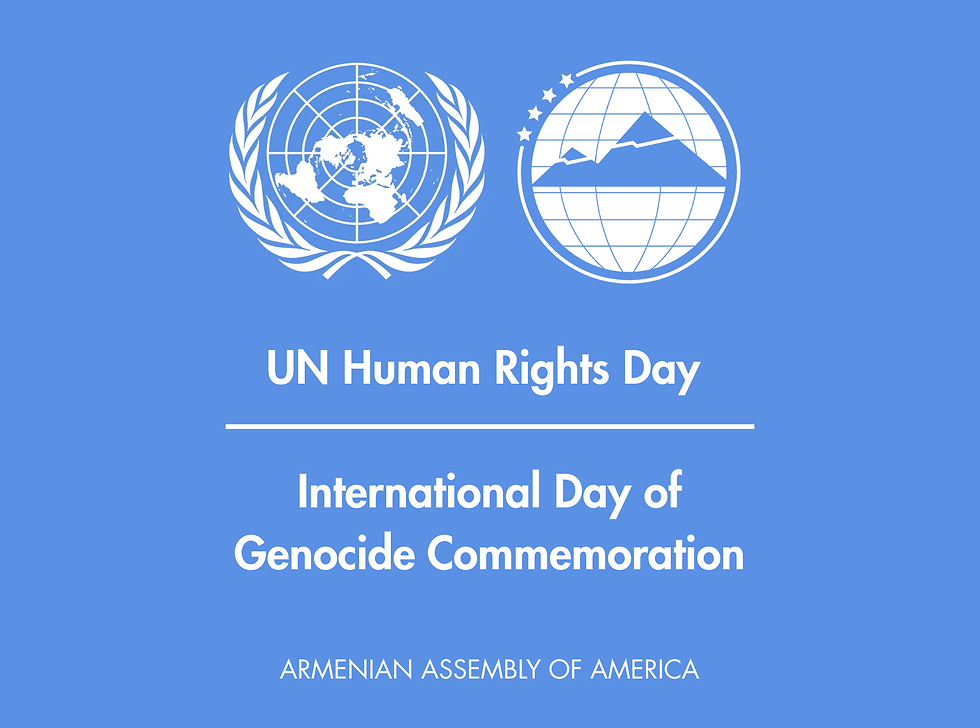Armenian Assembly of America, ANCA Discuss Armenian American Issues at Columbia University
- Armenian Assembly of America

- Nov 25, 2014
- 3 min read
Updated: Jul 29, 2021

(Stepan Atamian, Taniel Koushakjian, Haik Ter-Nersesyan, Armen Sahakyan, Aram Balian)
By Taniel Koushakjian (@Taniel_Shant)
AAANews Blog
Last week, the Armenian Society of Columbia University in New York City hosted a panel discussion entitled “The Armenian Lobby: Challenges & Opportunities.” The discussion brought together the Armenian Assembly of America (Assembly) and the Armenian National Committee of America (ANCA), the two Armenian advocacy groups in Washington, D.C.
Haik Ter-Nersesyan, President of the Armenian Society, opened the discussion and welcomed the audience. He introduced the panel and served as the evening’s moderator.
ANCA Eastern Region Director Armen Sahakyan began with an overview of the current legislative priorities of the Armenian American community, namely the US reaffirmation of the Armenian Genocide, US assistance to Armenia and Nagorno Karabakh, US assistance to Christians in the Middle East particularly those in Syria, assistance to the Javakh region of Georgia, and stopping the aggression of Azerbaijan President Ilham Aliyev against the people of Nagorno Karabakh (NK). Sahakyan talked about the latest challenges facing Armenia, the South Caucasus region, and Armenian American efforts to commemorate the 100th anniversary of the Armenian Genocide in 2015.

Assembly Communications Director Taniel Koushakjian provided an overview of the challenges and opportunities facing the Armenian American community. He took the audience through the Assembly’s 42-year history, discussing the past challenges of the Armenian Assembly and its accomplishments. Koushakjian talked about the founding fathers of the Assembly and the launch of the first internship program for Armenian students of Armenian descent, known today as the Assembly’s Terjenian-Thomas Summer Internship Program in Washington, D.C.
Koushakjian highlighted the role of the Assembly prior to Armenia’s independence, such as assistance provided during the 1988 earthquake in Gyumri. He noted that “the Assembly was founded 19 years before the Third Republic of Armenia was established following the fall of the Soviet Union,” adding that “As the region evolved, so too, has the Armenian Assembly.”
“The anti-Armenian pogroms in Baku, Sumgait and Kirovabad, Azerbaijan between 1988-1991, the declarations of independence by Armenia and Nagorno Karabakh, and the 1991-1994 NK War brought a new set of challenges to Armenian Americans,” Koushakjian said. At the same time, Armenia’s independence brought new opportunities, reminding the audience that “now that Armenia was an independent state, Armenian Americans were well positioned to advocate for US foreign assistance, and Armenia quickly became the largest per-capita recipient of US aid in the former Soviet Union.”

Koushakjian then steered the discussion to more recent efforts to advance Armenian issues on Capitol Hill. “While many of the challenges in the beginning of the Assembly’ tenure were tragic, life-or-death moments for Armenians around the world, the legislative efforts of the Assembly continued in parallel,” he said. Koushakjian highlighted the role of the Armenian Assembly during the 1991 Senate debate on the Armenian Genocide resolution, championed by then-Senate Majority Leader Robert Dole (R-KS). He also touched on the importance of Section 907 of the Freedom Support Act, signed into law in 1994, which bars US military assistance to Azerbaijan until they cease aggressive actions towards NK and lift their blockade on the country. Also, having worked on successful passage of the genocide resolution in the House Foreign Affairs Committee in 2007 and 2010, Koushakjian talked about the history of the genocide bill since it first passed Congress in 1975.

Finally, Koushakjian turned toward the future of Armenian American advocacy efforts and the current challenges and opportunities faced by the community. He shared his belief that “challenges to Armenian advocacy groups present renewed opportunities.” Koushakjian concluded by calling on the audience to engage with their peers on Armenian American issues and to call them to action in the coming weeks and months. “It is up to each and every one of us to play some role and I am confident that together we can be successful in our advocacy efforts and overcome the challenges we face.”

The panel was then opened up for questions from the audience. Both Sahakyan and Koushakjian shared their organization’s activities and approaches to addressing issues such as Armenians in Syria, energy resources in the South Caucasus, the recent downing of an Armenian helicopter in Karabakh by Azerbaijan, and united efforts to commemorate the Armenian Genocide centennial in the U.S. The level of insight and depth of understanding exhibited by the Armenian Society members and the general audience made for a lively discussion.

“We are very thankful to Taniel and Armen for being here today and having their professional input on matters of importance to the Armenian American community,” Ter-Nersesyan said.
#Karabakh #RobertDole #Genocide #Syria #HaikTerNersesyan #ANCA #Azerbaijan #Congress #Georgia #NagornoKarabakah #ArmenianAssemblyofAmerica #ArmenianGenocide #NewYorkCity #Gyumri #Washingtondc #Sumgait #Kirovabad #lobby #ArmenSahakyan #baku #Javakh #SouthCaucasus #MiddleEast #Turkey #ColumbiaUniversity #TanielKoushakjian #Armenia #CapitolHill


